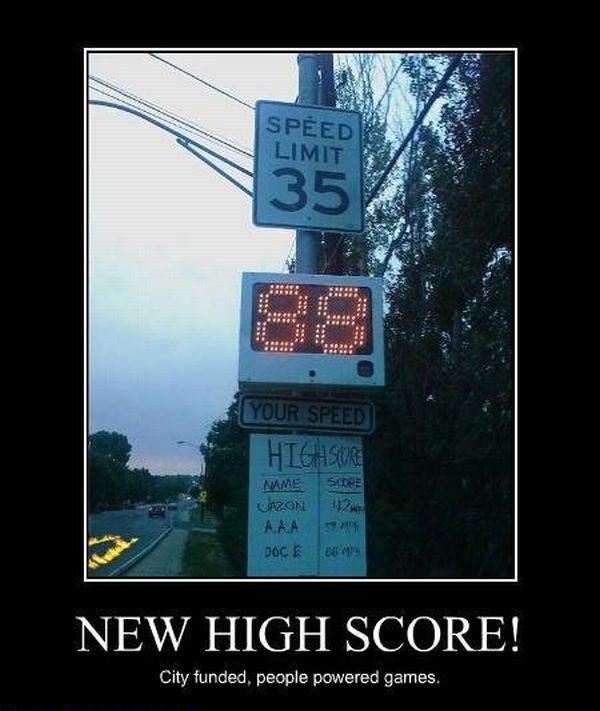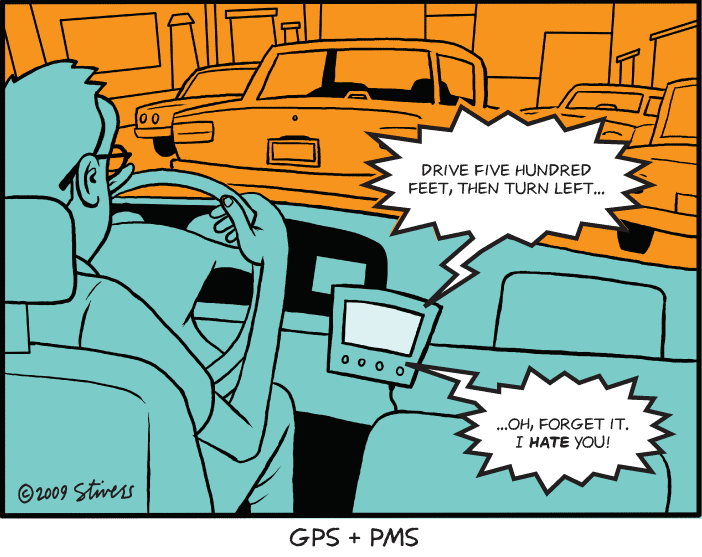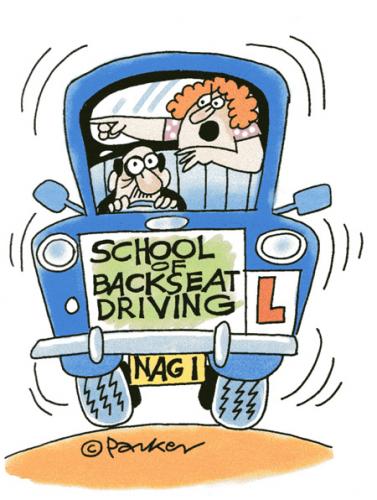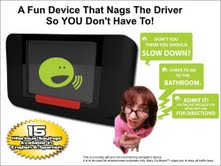Have you ever been in a car when a driver was paying too much attention to the GPS and not enough attention to the road?
If so, and it resulted in a fender bender, it probably felt like a case of technology failing to do what it’s supposed to— make our lives easier, safer and more entertaining.
Well three women visiting Bellevue Washington for a Costco convention ran into similar trouble Wednesday. According to KATU it was just after midnight and the ladies were looking for their hotel when the driver, lead by the rental GPS unit, drove their SUV down a boat launch and directly into a lake. Neither of her friends stopped her.
No one was hurt— one woman immediately lept to the dock, while the other two balanced on the door frames until the car sunk too deep and they had to wade to safety.
Granted, the boat launch was not well lit, but one has to ask: wtf?
I think the quotes that Lt. Eric Keenan with the Bellevue Fire Department best illustrate this mishap.
“We’ve seen sitcom parodies of something like this and to actually see it is surprising,” he said.
“They were trying to re-route their path and found this boat launch near the entrance to I-90 in South Bellevue and just kept driving into the water.”
“I don’t know why they wouldn’t question driving into a puddle that doesn’t seem to end.”
Well put, Keenan. While it sucks that the GPS lead them astray, this is not the case of technology failing a driver, rather a case of a driver temporarily failing life.
Remember when Mom or Dad would nag you about wasting gas by driving too fast? Now your car can do it for them.
Technology designed to coach you toward a more efficient style of driving is showing in many new cars. Options run the gamut from simple displays of fuel consumption, to interactive video games, to a gas pedal that actually pushes back when you stomp it.
Auto makers view these features as lures for younger, cash-conscious and tech-savvy buyers. They might also help car makers meet coming federal fuel-efficiency standards. Research indicates these electric noodges can make a significant dent in fuel consumption, if drivers actually follow the advice the systems give them.
Car makers are treading carefully. They want to engage their customers in the effort to conserve oil, but they don't want to irritate them and don't want to compromise safety by making eco-driving displays too distracting. Most of these technologies can be ignored or turned off if drivers choose.
At the far end of the in-car coaching spectrum is Nissan Motor Corp.'s Infiniti and its "Eco Pedal." It is a gas pedal that, in "Eco" mode, gently pushes back against your foot when the car's computers decide you're romping too aggressively on the accelerator. The brand began offering it as part of a $3,000 optional "technology package" with other advanced safety systems. About a fifth of the M-line buyers get the technology package, which also will be offered on the 2013 JX luxury crossover, due to be debuted in November, Infiniti says.
Hyundai Motor Co.'s sporty new 2012 Veloster three-door coupe has a fuel-economy game programmed into the screen that also displays the car's location, onboard entertainment and telecommunications. The "Blue Max" program measures the car's fuel economy every 10 minutes and displays a score. Drivers can share their score with other Veloster owners using the car's Blue Link wireless link.
Fuel economy is important to the Veloster's young, target buyers, says Hyundai Motor America's senior manager for product planning, Brandon Ramirez. "Gen Y is into gaming," he says, which is why they chose a videogame format. Although the car just came out, Veloster owners are already comparing their scores in an online forum.
It wouldn't be the first time drivers have turned trimming fuel use into a game: Some owners of hybrids and other cars compete with themselves and each other by "hypermiling," using various techniques to cut gasoline usage.
Ford Motor Co. uses images of a plant that grows as drivers motor more efficiently in its Fusion Hybrid model. And Toyota's Prius and Camry hybrids offer detailed, displays of real-time fuel economy.
Auto makers are experimenting with these features in part because future federal fuel-economy regulations could give them valuable credits under the Corporate Average Fuel Economy, or CAFE, rules for installing them. And researchers have found that gentle nagging by coaching systems works.
Researchers at the University of California, Riverside have been experimenting with ways to give drivers instantaneous feedback on their driving efficiency for about five years. UC Riverside researchers equipped the cars of about 20 people with devices that gave them information about their real-time miles per gallon. Seeing that information led to savings ranging from 5% to 15%, researchers say.
Now, the researchers are embarking on a larger, three-year study, funded with $1.2 million from the Department of Energy. It's aimed at finding how much drivers can save if they have detailed information on the most fuel-efficient route to a destination—based on traffic and road conditions—coupled with coaching technology giving drivers instantaneous performance feedback.
Savings "could go up to 30% under ideal scenarios," says Kanok Boriboonsomsin, one of the researchers on the project. It's a worthy goal, as boosting a car's mpg by 30% through hardware changes—lighter materials, new transmissions, or tiny engines—can be expensive.
Still, the word "ideal" is important: Ideal conditions for driving in a fuel-saving manner aren't easy to find or sustain.
I took a spin in one of the UC Riverside's test vehicles—a heavily modified Nissan Altima bristling with computers and antennae. Accelerating out of the parking lot, my real-time mpg sank well below the roughly 20-mpg target for city driving on the screen.
Things improved coasting downhill, but when I accelerated up the on-ramp to merge with traffic, my real-time fuel economy dipped below 10 mpg.
Michael Todd, a UC Riverside researcher who chaperoned my drive, says mashing the accelerator to get on a freeway can overwhelm the car's exhaust-scrubbing systems. So, not only is the car burning a lot of fuel, but it's adding a bigger-than-average load to air pollution.
The message from the UC Riverside data is that relatively small changes in behavior can produce fairly substantial reductions in fuel consumption.
The overall problem, Mr. Todd says, is that "most people aren't taught how to conserve fuel" when they learn to drive.
Technology designed to coach you toward a more efficient style of driving is showing in many new cars. Options run the gamut from simple displays of fuel consumption, to interactive video games, to a gas pedal that actually pushes back when you stomp it.
Auto makers view these features as lures for younger, cash-conscious and tech-savvy buyers. They might also help car makers meet coming federal fuel-efficiency standards. Research indicates these electric noodges can make a significant dent in fuel consumption, if drivers actually follow the advice the systems give them.
Car makers are treading carefully. They want to engage their customers in the effort to conserve oil, but they don't want to irritate them and don't want to compromise safety by making eco-driving displays too distracting. Most of these technologies can be ignored or turned off if drivers choose.
At the far end of the in-car coaching spectrum is Nissan Motor Corp.'s Infiniti and its "Eco Pedal." It is a gas pedal that, in "Eco" mode, gently pushes back against your foot when the car's computers decide you're romping too aggressively on the accelerator. The brand began offering it as part of a $3,000 optional "technology package" with other advanced safety systems. About a fifth of the M-line buyers get the technology package, which also will be offered on the 2013 JX luxury crossover, due to be debuted in November, Infiniti says.
Hyundai Motor Co.'s sporty new 2012 Veloster three-door coupe has a fuel-economy game programmed into the screen that also displays the car's location, onboard entertainment and telecommunications. The "Blue Max" program measures the car's fuel economy every 10 minutes and displays a score. Drivers can share their score with other Veloster owners using the car's Blue Link wireless link.
Fuel economy is important to the Veloster's young, target buyers, says Hyundai Motor America's senior manager for product planning, Brandon Ramirez. "Gen Y is into gaming," he says, which is why they chose a videogame format. Although the car just came out, Veloster owners are already comparing their scores in an online forum.
It wouldn't be the first time drivers have turned trimming fuel use into a game: Some owners of hybrids and other cars compete with themselves and each other by "hypermiling," using various techniques to cut gasoline usage.
Ford Motor Co. uses images of a plant that grows as drivers motor more efficiently in its Fusion Hybrid model. And Toyota's Prius and Camry hybrids offer detailed, displays of real-time fuel economy.
Auto makers are experimenting with these features in part because future federal fuel-economy regulations could give them valuable credits under the Corporate Average Fuel Economy, or CAFE, rules for installing them. And researchers have found that gentle nagging by coaching systems works.
Researchers at the University of California, Riverside have been experimenting with ways to give drivers instantaneous feedback on their driving efficiency for about five years. UC Riverside researchers equipped the cars of about 20 people with devices that gave them information about their real-time miles per gallon. Seeing that information led to savings ranging from 5% to 15%, researchers say.
Now, the researchers are embarking on a larger, three-year study, funded with $1.2 million from the Department of Energy. It's aimed at finding how much drivers can save if they have detailed information on the most fuel-efficient route to a destination—based on traffic and road conditions—coupled with coaching technology giving drivers instantaneous performance feedback.
Savings "could go up to 30% under ideal scenarios," says Kanok Boriboonsomsin, one of the researchers on the project. It's a worthy goal, as boosting a car's mpg by 30% through hardware changes—lighter materials, new transmissions, or tiny engines—can be expensive.
Still, the word "ideal" is important: Ideal conditions for driving in a fuel-saving manner aren't easy to find or sustain.
I took a spin in one of the UC Riverside's test vehicles—a heavily modified Nissan Altima bristling with computers and antennae. Accelerating out of the parking lot, my real-time mpg sank well below the roughly 20-mpg target for city driving on the screen.
Things improved coasting downhill, but when I accelerated up the on-ramp to merge with traffic, my real-time fuel economy dipped below 10 mpg.
Michael Todd, a UC Riverside researcher who chaperoned my drive, says mashing the accelerator to get on a freeway can overwhelm the car's exhaust-scrubbing systems. So, not only is the car burning a lot of fuel, but it's adding a bigger-than-average load to air pollution.
The message from the UC Riverside data is that relatively small changes in behavior can produce fairly substantial reductions in fuel consumption.
The overall problem, Mr. Todd says, is that "most people aren't taught how to conserve fuel" when they learn to drive.




![[EYESROAD]](http://si.wsj.net/public/resources/images/PJ-BD437_EYESRO_G_20111025190200.jpg) Hyundai
Hyundai 






































 This make's a great gag gift for Father's Day
This make's a great gag gift for Father's Day